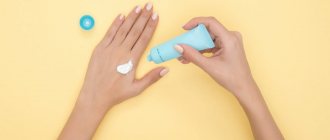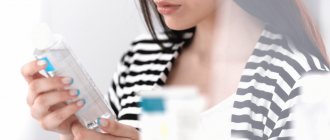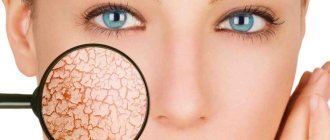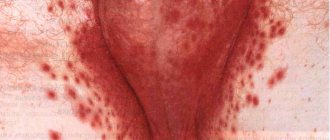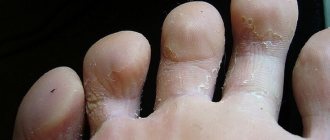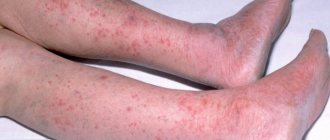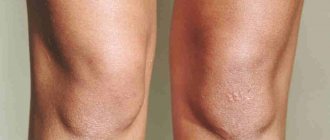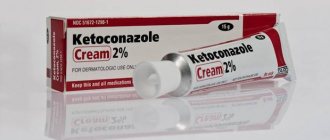Dry hand skin is a common problem characterized by a decrease in moisture in the outer layer of the skin - the epidermis. According to statistics, every fifth person worldwide suffers from dry skin1.
Very dry skin of the fingers and hands is an alarming sign of a violation of the barrier properties of the epidermis, which can be temporary or long-term. People with this condition have a feeling of tightness, the skin is easily irritated, becomes sensitive to external influences, becomes flabby, and less elastic. If you do not take any action, a whole range of unpleasant symptoms will appear in the future, such as:
- change in surface relief;
- the appearance of small wrinkles and microcracks;
- peeling;
- signs of an inflammatory process.
Hydrolipid film is a natural barrier consisting of exfoliated horny scales, sebum, sweat, microflora and organic acids. In case of severe imbalance of the components of the water-fat film, a pathological condition of the skin develops - xerosis. The skin of the hands begins to peel off, and many small grayish-white scales appear on it. It becomes dull and rough. Sometimes there are areas of redness, superficial or deep cracks. These changes are accompanied by a feeling of tightness, itching, tingling, pain (especially when in contact with external factors2.
When the permeability of the skin barrier is impaired, the surface of the hands becomes vulnerable to infectious (bacterial, viral, fungal) and chemical agents. When the skin is frequently damaged, the cells of its upper layer (epidermis) produce cytokines - substances that initiate and maintain inflammation. Therefore, the characteristics of dry skin are sensitivity to irritation, susceptibility to allergies and infections3.
The skin on the palms of the hands is peeling and peeling: reasons
In many cases, this phenomenon has completely obvious roots and does not require a long investigation. These include:
- influence of air temperature;
- overdrying;
- exposure to chemical agents;
- mechanical damage (for example, rubbing with jewelry, watch straps, etc.).
In some cases, you can decide on your own: use a cream or special cosmetic oil. But if the irritation does not go away, then a doctor must identify the cause. This can be either an allergic reaction or a skin disease, so a detailed diagnosis is necessary.
What to do with dry hand skin?
If the skin on your hands has become dry, your palms are flaky, or your hands feel unpleasantly dry, the skin is most likely having difficulty retaining moisture. This can happen if the natural protective barrier of the skin, its hydrolipid mantle, is disrupted.
Repairing cream for very dry hands CeraVe
CeraVe restoring cream for very dry hand skin contains components aimed at strengthening the hydrolipid barrier and intensively moisturizing the skin. Let's look at them in more detail:
Ceramides: these are lipids that help maintain the protective functions of the skin and help restore and strengthen its hydrolipidic barrier.
Hyaluronic Acid: Draws moisture into the upper layers of the skin, helping to maintain hydration for a long time.
Phytosphingosine: is a phospholipid that helps strengthen the skin's own protective functions. It helps reduce moisture loss from the upper layers of the skin and protect it from dehydration.
CeraVe Revitalizing Cream is formulated with MVE technology, a gradual release of active ingredients that helps provide long-lasting hydration to the skin. It is fragrance-free, paraben-free, hypoallergenic and suitable for very dry hands.
Revitalizing hand cream
For very dry skin
Moisturizes dry, chapped hands, helping to restore and strengthen the protective skin barrier.
More details
What is causing the problem
The reasons for the deterioration of the palms and fingers are very diverse and are divided into several groups.
- Physical. These include air temperature, wind, humidity, sun, friction, and so on.
- Chemical. Why the hands of people who work with chemically active substances dry out and peel does not raise any questions. However, we must not forget that household washing powders and detergents that are used at home can also cause irritation.
- Biological. Pollen and plant sap have a negative effect on us, often this effect is seasonal.
- Internal. Disruption of various organs also leads to this problem. The reasons may range from problems in the digestive system to malfunctions of the endocrine glands. In this case, diagnostics must be carried out by a specialist.
Allergic reactions
The manifestation of irritation can occur after either single or systematic contact with the allergen. For this reason, the problem may worsen at certain times of the year, as well as when consuming specific products, cosmetics, or contact with synthetic materials. In some cases, the question of the reasons does not even arise - the person knows well what exactly he has a negative reaction to. But at the first appearance of unpleasant symptoms, it is necessary to analyze why exactly they arose, what became the impetus for negative manifestations. The doctor’s diagnosis in this case may sound like atopic or contact dermatitis, eczema, urticaria, in many cases itching is added to the deterioration of the external integument.
Lack of vitamins: why the palms of your hands peel so much
Vitamin deficiency and other metabolic problems can lead to deterioration of the epidermis. It is also necessary to enrich the diet with essential microelements and other nutritional components that have a beneficial effect on the condition of all organs and systems. These include the following vitamins:
- A – increases the resistance of the epidermis, protects against infections, protects against the formation of small cracks and increases elasticity.
- E (tocopherol acetate), called the vitamin of youth, is an effective antioxidant that successfully fights aging, reduces itching and prevents severe reactions to environmental influences.
- F – makes the epidermis more elastic, regulates its moisture and accelerates the healing of minor damage.
- Provitamin B5 (panthenol) – normalizes water balance, which is very important if you have severe peeling of the skin on your hands; accelerates the healing of small wounds and regeneration, increases the strength of collagen.
In addition to vitamins, urea has a beneficial effect on the outer skin, thanks to which the keratinized areas absorb more water, which means their condition is normalized. Urea also easily penetrates into the deep layers of the epidermis and helps the absorption of active ingredients. To improve the condition of your fingers, you need zinc. You can get all these necessary components both through a varied diet and by taking special complexes that will be recommended to you individually.
Improper care
What to do if the skin on your hands is peeling, the doctor will be able to answer only after examination and diagnosis. One of the most common reasons is the wrong choice of cosmetics. First of all, this applies to the use of creams and other formulations that match the type of dermis. For example, those with high fat content may abuse alcohol and drying agents and use them too often. As a result, such care leads to a violation of the integrity of the lipid layer, the epidermis loses protection and moisture, dries, and cracks. And there can be many examples of such errors leading to a wide variety of violations.
Consequences of antibiotic treatment
After an illness that is in no way related to pathologies of the external integument, many patients note that the skin on their hands is very flaky - the reasons are due to therapy with antibacterial drugs.
It is known that they can cause side effects, including affecting the condition of hair, nails, and so on. Some medications cause the following skin problems:
- redness;
- hives;
- acne;
- exacerbation of dermatoses.
Quite often, the effects of antibacterial therapy do not appear immediately, but 2-3 weeks after the start of treatment. This can make diagnosis difficult - the cause is sought in care errors or disturbances in habitual nutrition. In fact, the impetus for the deterioration of the condition is the therapy being carried out: the doctor chooses the wrong drug, the active substance that is not suitable specifically for you. In this case, you can take an antihistamine, which will help relieve discomfort and eliminate adverse reactions.
Masks to eliminate dry hands and heal wounds
When cracks appear on the fingers, they are treated in various ways, including traditional methods: baths, masks, oils. There are several proven recipes for hand masks that are easy to prepare at home:
- 1 boiled potato is mixed with 1 tablespoon of milk. The mixture is applied to the wounds, paying special attention to where the fingers peel the most. The mask is used as a compress: wrap your hands in cellophane for half an hour.
- Honey-sea buckthorn mask: mix sea buckthorn oil and honey in a ratio of 3:1. The mixture is applied to the damaged areas for half an hour, after which it is washed off, then lubricated with medicinal ointment.
- Oatmeal mask: pour boiling water over the required amount of oatmeal and wait until it swells. The mixture is carefully applied to the hands, trying to cover all areas: the space between the fingers, the skin near the nails. Fifteen minutes of exposure will be enough. After the procedure, you should lubricate your hands with any suitable cream.
You should not use herbal decoctions to remove the mask, as they have a drying property. It is better to lubricate your hands with medicinal or cosmetic cream after rinsing with warm water.
Dermatological problems
When they say that the skin is the largest human organ, there is no exaggeration in this. Its area is really about 2 square meters. m, and the number of diseases to which it can be susceptible is also quite large, especially since this is the body’s first protective line. It is affected by most possible external negative factors, and is also attacked from within. It is not without reason that they say that disruptions in the functioning of organs and systems affect appearance. Therefore, if the skin on your hands is peeling, there can be a variety of reasons.
Dermatological diseases are divided into:
- infectious – arising from an attack by pathogenic flora;
- fungal;
- viral (including herpes, warts, and so on);
- purulent and pustular;
- allergic;
- parasitic;
- oncological
Deterioration of the epidermis is not the only manifestation of these diseases, but it often occurs with pathologies of various types. That is why, if you are concerned about the condition of your palms and fingers, treatment is prescribed after a doctor’s examination and detailed diagnosis.
Fungal infection
Mycoses have recently become more common. Patients contact a dermatologist with a complaint of peeling skin on the arm in one place. With a fungal infection, foci of altered epidermis actually form on the limbs and body; they usually have a round or elongated shape, the color varies from pink to red. In the vast majority of cases, such problems arise after contact with animals, as well as with objects that were previously in contact with fur. Treatment of the fungus is prescribed by a doctor; if the lesions are isolated, you can usually get by with external means. For extensive cases, a specialist may prescribe antibiotics.
Scabies
Many people believe that this disease is a thing of the past, but even today it is becoming a common cause of peeling hands - your doctor will definitely advise you on what to do in this situation. The primary source of this unpleasant pathology is the influence of a parasite – the scabies mite, which is transmitted from person to person. The higher the probability of infection, the more tick burrows there are on the outer surfaces of the sick person; family members of the patient are at increased risk.
The first and main symptom of scabies is itching. It can be present on different parts of the body except the face and head. A distinctive sign of the disease is exacerbation in the evening, as well as at night. You will get the reason for this condition from your doctor after an examination. But you can suspect an unpleasant pathology yourself: tick burrows look like characteristic white stripes that are clearly visible to the naked eye.
Dermatosis
This term combines various diseases in which skin lesions occur due to a variety of reasons. Problems can be congenital or acquired, manifest themselves to a greater or lesser extent, and go through periods of exacerbation and remission. Usually, with this diagnosis, the hands are very flaky or redness appears. Main manifestations:
- itching;
- peeling;
- rash;
- burning;
- edema.
Dermatoses can be caused by disruptions of the endocrine system, disruptions in the immune system, as well as various external factors, including exposure to microorganisms.
Psoriasis
This is a chronic disease that can also affect nails, joints and internal organs. The difficulty of its treatment is that its causes are still not completely clear. A number of provoking factors have been identified, but doctors today do not have a complete understanding of the etiology of the disease. In most cases, pink-red rashes appear on the epidermis; papules can merge into large plaques. Psoriasis also causes peeling of the skin on the hands of men; the causes of the disease in them may lie in previous injuries, lipid metabolism disorders, and so on.
The occurrence of pathology can be provoked by:
- microbes and fungi;
- stress, neuropsychological tension;
- infectious diseases;
- metabolic disorders, in particular protein and lipid metabolism;
- injuries;
- endocrine pathologies, including diabetes;
- disruption of the immune system.
Eczema
This word comes from Greek and means “to boil.” And one concept really quite accurately describes what a person feels: a burning sensation, the appearance of blisters, great discomfort. This is a chronic disease that can affect anyone and causes peeling skin on the hands of both men and women. Unpleasant symptoms may appear on the palms, legs and various parts of the body. The rashes on the body are symmetrical, and they are accompanied by swelling. Also, at the site where the lesions appear, bubbles filled with liquid form.
Contact dermatitis
Such damage occurs precisely when it comes into contact with substances that a particular person cannot tolerate. These can be both the most obvious options - pollen, perfumes, animal hair, and non-obvious ones. The disease can occur, for example, through contact with rubber (in particular, when wearing rubber gloves at work), with metal surfaces, and so on.
When looking for reasons why fingers peel, doctors often assume this pathology first. There are also a number of so-called conditioned stimuli to which only people with very sensitive epidermis react. In each specific situation, the substance to which a pronounced reaction occurs is determined by the doctor based on the results of skin tests.
Treatment methods for cracked fingers
If the integrity of the epidermal layer of the skin of the hands is damaged, it is necessary to use complex therapy. First of all, attention is paid to the diet. The patient is recommended to eat fatty fish and seafood (high in Omega 3).
Omega-3 content in products
Vitamins A, E and B should be supplied to the body every day with food. It should also be rich in micro and macroelements and coarse fiber. During the treatment process, it is recommended to limit the consumption of hot and spicy foods, fatty meats, and smoked foods. A complete taboo applies to any type of alcoholic beverages.
You should know! During the treatment process and after it, it is necessary to ensure sufficient fluid intake. It reduces the likelihood of dry skin.
An important point in therapy is daily hygiene. In this case, the patient is recommended:
- when in contact with detergents and cleaning products, wear gloves;
- apply a respecting cream to your hands at least 2 times a day;
- Wipe manicure items with alcohol before use.
Drug therapy for cracked fingers
The prescription of medications takes into account the type of disease, since therapy should be aimed at the cause of the pathological process, and not at its consequence. Based on this, treatment of finger cracks occurs using the following drugs:
- Erius, Suprastin, Tavegil, Zyrtec are used in the complex therapy of allergic dermatitis. If there is no effect, drugs from the glucocorticosteroid group (Lokoid, Hydrocortisone ointment) are used.
Preparations for the treatment of allergic dermatitis - For mycoses, therapy is carried out using Fluconazole or Ketoconazole. Ointment-based drugs (Lamisil, Miconazole, Zalain) are used locally.
- In case of psoriatic lesions, Flucinar, Akriderm, Ekolom, Hydrocortisone ointments are used.
- Diabetes mellitus requires correction of insulin production. Additionally, Ureata cream and DiaDerm Cream-talc are prescribed.
Commonly prescribed ointment-based drugs
In complex therapy, for various pathologies, with the appearance of symptoms of cracks in the hands, practicing dermatological specialists recommend using the following ointments:
- Boro Plus. The therapeutic effectiveness is explained by the presence of a natural composition (sandalwood extract, turmeric, aloe). It has a pronounced antiseptic effect and eliminates the symptoms of dry skin. Approved for use from the age of three. Apply a thin layer 2 times a day. Does not apply if one of the ingredients becomes an allergen for the patient.
Boro Plus, ointment for the treatment of dry skin - Rescuer. The main components are sea buckthorn oil, propolis, purified beeswax. Accelerates the healing of wound surfaces. Positive dynamics from the use of the ointment is observed when used at least 3 times a day. Allowed for use by children over 1 year of age.
- Calendula ointment. It has a pronounced antibacterial effect, relieves skin itching and increases epidermal regeneration. The frequency of use is 2 to 3 times a day. If necessary, apply as a compress.
- Levomekol. Antibacterial ointment used for skin lesions. To relieve negative symptoms, apply twice a day.
Levomekol, ointment for the treatment of skin lesions - Prednisolone ointment. The rapid development of the therapeutic effect is facilitated by Prednisolone (adrenal cortex hormone). The ointment can eliminate inflammatory processes in eczema, psoriasis and dermatitis. It is recommended to use no more than 3 times a day.
Any type of hormonal ointment is prescribed only by a doctor, for a short course. Otherwise, it can accumulate in the body and cause atrophic changes in the skin.
- Exoderil. The most popular drug in the treatment of mycoses. Due to the high level of penetration, it is not recommended for use in any trimester of pregnancy.
Exoderil, ointment for the treatment of nail and skin fungus - Balsam. It contains vitamins A and E. Using it several times a day eliminates the symptoms of itching, flaking, and dryness. Due to this, the skin surface becomes soft and elastic.
Traditional healing methods for cracked fingers
In most cases, the traditional healing recipe for cracks in the fingers is used as an additional method of treatment. The main goal of all procedures is to moisturize the skin and activate regeneration processes in the epidermis.
Important! Before using any folk recipe, you must consult a doctor. This is due to the fact that concentrated use of herbs can provoke the development of allergic reactions.
Popular traditional healing recipes for dry and cracked hands:
- Baths from chamomile inflorescences
Baths from chamomile inflorescences. Add 5 drops of tea tree infusion to the chamomile decoction (500 ml). Hands are immersed in the solution for 10 minutes. After the procedure, they are moisturized with a nourishing cream. - Compresses with olive oil. To speed up the regeneration process, the oil is applied to a cotton pad and applied to the affected area. After fixing with a plaster, gloves are put on your hands.
- Honey with sea buckthorn oil has an antibacterial effect and moisturizes the skin of the hands. Each ingredient is mixed in equal proportions and applied to hands before going to bed (gloves must be used). In the morning, the composition is washed off with warm water.
- Mask with raw potatoes. Several tubers of raw potatoes are grated or passed through a blender. Egg yolk is added to the resulting slurry, after which the composition is applied to the skin of the hands. The procedure time is 15 minutes. It is carried out once a week.
Treatment of the disease
Often people who suffer from poor dermal conditions try to simply relieve the symptoms. They apply cream, medicinal ointment (purchased independently), and even take pills. However, the first step is always to limit contact with those substances that caused a change in her condition. If the skin on your hands is peeling, the causes and treatment will differ in different cases, so the second stage will be an examination by a doctor, who will tell you how to completely get rid of peeling. The use of recommended cosmetics and medicines must be carried out according to a scheme approved by a specialized specialist. Some need additional hydration, others need intensive nutrition, and others need to take care of restoring the protective cover. In some cases, the use of hormonal therapy is required.
Using quality cosmetics
The very first and most common method of combating dryness is to use high-quality cosmetics that suit your type. If creams, oils and emulsions are recommended to solve certain problems, then they should be used in the mode recommended by the doctor or cosmetologist. Otherwise, cosmetics may not provide a therapeutic effect, but aggravate the problems. For example, excessive use of drying agents leads to thinning and disruption of the integrity of the lipid film. Aggressive peelings, which many people with epidermal diseases use on their own, injure it. And nutrients chosen incorrectly clog pores and disrupt metabolism.
Medications
Peeling of the skin on the hands of men and women can have a different nature, including those associated with the nature of professional activities and the frequency of trauma. However, treatment is carried out in the same areas:
- the use of drugs that prevent moisture loss;
- use of replacement therapy;
- creating hydration;
- restoration of the epidermal barrier;
- activation of regenerative processes;
- use of antifungal, antiviral, antibacterial drugs.
Treatment with folk remedies
The easiest way to solve the problem is to try changing cosmetics and care. There is a scheme according to which you need to take care of yourself comprehensively: cleanse, tone and moisturize. Often this scheme actually improves the appearance. But there are a number of nuances here too. For cleansing, it is recommended to use gentle products, including very mild peelings. You can try delicate rolls that are used for the face. Among the widely used skin softeners, we can recommend petroleum jelly, saturated fats, as well as cosmetics with hyaluronic acid and urea, but the latter must be used with caution: in winter it is not recommended to go outside with such cosmetics.
Treatment by a cosmetologist
One of the most popular ways to improve the condition of the epidermis with the help of specialized specialists is biorevitalization. Injections of preparations containing hyaluronic acid help regulate water balance in a physiological manner. This ingredient retains water molecules, which means healing occurs from the inside.
Treatment with the drug "Laennec"
Regardless of why the skin on women’s hands peels, the reasons, as we have already explained, can be very different; many patients are prescribed therapy with medications made from human placenta. One of them is the Japanese multicomponent drug “Laennec”, which includes peptides, amino acids, vitamins, micro- and macroelements.
Being an effective immunomodulator, it helps solve many problems, including atopic dermatitis, and can reduce the severity of peeling, as well as the need for corticosteroids and antihistamines.
A study conducted at the Institute of Immunology of the Federal Medical and Biological Agency of Russia showed that the use of Laennec helps reduce itching, dryness, and reduce papular rashes.
- Being an immunomodulator, it improves the protective qualities of the skin.
- The drug has a beneficial effect on the state of the intestinal flora, which is also very important.
- Growth factors in Laennec promote regeneration of the epidermis and regression of rashes.
Associated symptoms
Often, xerosis is a temporary phenomenon that is disturbing during the cold season. The intensity of the manifestation depends on the general condition of the body, age, and the presence of pathological causes. Additional symptoms may indicate that the condition is caused by a disease:
- redness that spreads to adjacent areas of the skin;
- feeling of tightness, discomfort;
- microcracks;
- wrinkled, dehydrated skin;
- increasing itching;
- the appearance of wounds and ulcers that are difficult to heal;
- roughening of the skin, thickening of the top layer.
Depending on the pathogenesis of the disease, the dermatologist will prescribe a comprehensive treatment regimen with procedures and medications.
Prevention of peeling
If you constantly have a question about why your hands peel, what to treat and how to prevent this problem, we recommend paying attention to preventive measures:
- Normalization of diet. Enriching food with vitamins and microelements will help improve the condition of the dermis. You can either increase their consumption with food or take special complexes.
- Avoiding contact with allergens and substances that most often cause irritation.
- Drink enough water, at least 2 liters per day.
- Protection from ultraviolet radiation, which easily dries out.
- Using cosmetics that suit your type.
Laennec drug and super-thin injection needles Nanoneedle
Laennec - injection solution No. 10
Curacen / Curacen
Nanoneedles with ultra-thin walls 30G
Nanoneedles with ultra-thin walls 33G
Prevention of cracked fingers
Preventive measures help prevent the development of damage to the upper layer of the epidermis on the hands. For this purpose, the following rules and recommendations must be observed:
- do nourishing hand baths once a week;
- in case of contact with household chemical products, wear rubber gloves;
- if there has been contact with water for a long time, you need to use a moisturizer;
- any damage to the skin should be treated with antiseptic solutions;
- When performing a manicure, use individual devices.
Healthy food and a balanced diet is an equally important preventive measure to prevent damage to the integrity of the skin on the hands.
The appearance of cracks in the fingers of the upper limbs should be taken seriously. They can signal the development of serious pathologies. Therefore, you should not self-medicate. A timely visit to a doctor will avoid negative consequences and the progression of the disease to an advanced form.
Features of seasonal care for dry skin
What to do and how to deal with very dry skin in winter and summer? Will basic care methods vary depending on the season? Yes - and now we will tell you how.
Care in autumn and winter
Dry hands in the autumn-winter period is one of the common problems in both women and men. The skin of your hands may peel, suffer from dryness and a feeling of tightness... The following measures will help combat the fact that your palms or fingers are peeling:
- Use special hand products designed for use before going outside, and moisturizing and restorative products after returning home.
- Try not to appear outside without gloves, protect your hands from temperature changes and sharp winds.
- Do not forget to regularly moisturize your hands when in a room where heating devices are operating.
Care in spring and summer
If your hands peel in the warm season, it may also be a matter of incorrectly chosen care, or a possible lack of vitamins and minerals in the diet. Here's how you can try to fix this situation:
- Try not only to moisturize the skin of your hands, but also to protect it from aggressive sun rays using cosmetics with SPF protection.
- Remember to drink enough clean water to prevent general dehydration.
- Watch your diet: eat more vegetables, fruits, fatty fish and other sources of skin-healthy nutrients.
